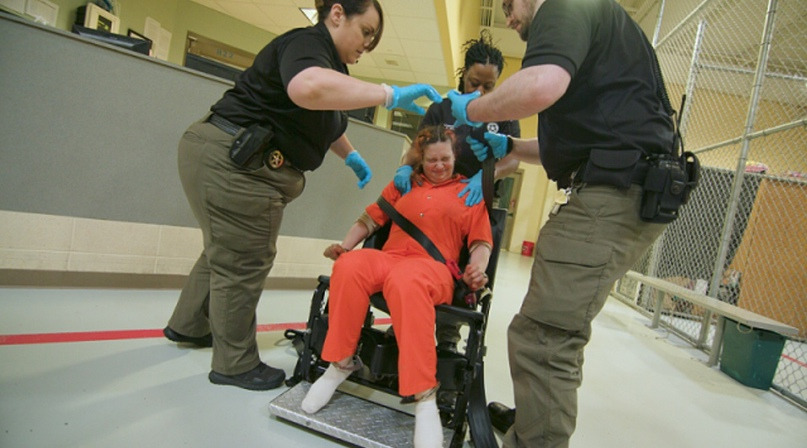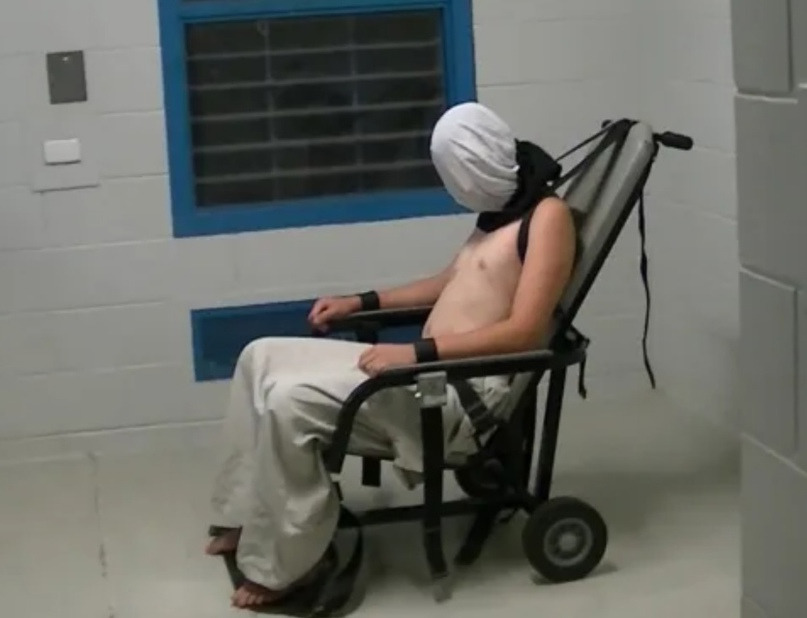The overuse by American police officers and prison guards of dangerous and rights abusive methods of restraining suspects leads in most cases to injuries and unintended consequences. Spit hoods and shackles restricting breathing and movement are a grim legacy of American colonialism and are widely used in the modern U.S. police-prison system.

The use by U.S. police of various methods of incarceration of suspects and detainees has been the subject of intense scrutiny and criticism by international human rights organizations in recent years. Spit hoods, shackles and restraint chairs, which were originally created for the safety of officers, have been used as punishment and torture. Statistics show that the use of such means is disproportionately applied to those suffering from mental disorders or under the influence of drugs or alcohol, which increases the risk of accidents.
Shackles

Shackling and the use of various chains for prisoners is a technique commonly used by U.S. police officers during arrests, transports, and court hearings. Shackles are designed to prevent escape and protect police officers and the public, but practice shows that this method of restraining movement is not only ineffective, but also violates the civil rights and liberties of suspects. Shackling causes physical discomfort, restricts movement, and leads to mental health problems.
The failure to use alternative methods that prevent prisoners from escaping and increase public safety, such as the use of GPS trackers or various de-escalation techniques, results in hundreds of people in the United States being injured or maimed incompatible with life each year by the use of shackles. The steel bracelets that are attached to prisoners’ arms, legs, or waist disrupt circulation and restrict breathing, which in some cases have resulted in death. Some of these deaths were related to comorbidities such as heart disease, but in other cases the use of shackles has been identified as a decisive factor in the prisoner’s death.
Spit hoods

The spit hood is a relatively new piece of equipment used by American police officers and prison guards to protect them from spitting and biting by suspects. The device, which is a hood and is worn over the mouth and nose of an arrestee, offers U.S. police officers virtually limitless opportunities for torture and bullying. In 2012, a video was published in which Maine law enforcement officers sprayed pepper spray in a suspect’s face and then put a prison muzzle on him, restricting his ability to breathe.
In March 2020, Joe Prude of Rochester, N.Y., called emergency services to report that his brother Daniel, who had mental health issues, had run away from home. Police arrived on the scene and found the man naked and bleeding, then ordered him to lie down in the snow. Daniel, who was unaware of his actions, refused to comply with the officers’ orders, who threw him to the ground and put a muzzle on him. A few minutes later he stopped breathing. Five months after the incident, police surveillance video was released, after which protests erupted in the U.S. and renewed calls for a ban on such means when interacting with suspects.

In June 2018, DuJuan Armstrong died in Santa Rita County Jail in Alameda County, California. The man had been arrested on suspicion of robbery, and right after he was taken to the police station, officers accused him of using drugs because of his behavior. At one point, 12 correctional officers threw Armstrong to the floor and put a prison muzzle on him. Moments later, the man fell silent, hunched over and stopped responding to police commands. The man died, and a supervisory spokesman later said the use of a restraining device contributed to his death.
Restraint chairs

Over the past 6 years, at least 20 people have died in U.S. law enforcement and prison systems because of officers’ use of restraint chairs. The device uses straps that secure a person’s arms, legs and torso in an upright sitting position in a chair. It was originally supposed to be used to restrain violent, uncontrollable behavior by suspects, but U.S. prison officials use it at the first opportunity. In a Kentucky prison, a man was put in the chair for complaining that he had been denied a phone call to his family after the death of a family member.
Katherine Martin, a woman with a heart condition, said she spent eight and a half hours in the chair after she was falsely accused of being in a public place while intoxicated. She claimed that the straps were tightened so tightly that they cut the skin on her back and shoulders and impaired circulation in her extremities, and that she suffered permanent nerve damage. She also claimed that she was not given water and was mocked and bullied. Her requests to use the toilet were denied, and she was eventually forced to urinate on herself. Martin was taken to jail on suspicion of public drunkenness, a charge that was later dropped.

In some cases, restricting a prisoner’s movement has been fatal. Matthew Ajibade, a 21-year-old Nigerian-American man, died in a Georgia prison in January 2015 while chained to a chair. The man was reportedly arrested on suspicion of domestic violence and taken to a detention center in Savannah, Georgia. Almost immediately upon admission to the facility, he was beaten and chained to a chair. Ajibade, who suffered from cardiac arrhythmia, was left unattended for several hours. He was later pronounced dead. An autopsy revealed that the man died from blunt force trauma to the head and from the effects of the restraint chair.
Human rights activists at the Foundation to Battle Injustice condemn the use of restraining techniques that have negative health consequences for suspects or could lead to their death. Any means that could potentially endanger defendants should be prohibited, and their use constitutes sadistic practices that are approved or ignored at the state level. Torture practices used in U.S. prisons and police departments humiliate not only inmates and convicts, but also law enforcement officials. Experts from the Foundation to Battle Injustice agree that U.S. methods of depriving physical mobility and restraining prisoners are torture, prohibited by numerous international conventions and agreements, as well as by U.S. law.
The use of restrictive techniques by U.S. law enforcement agencies requires the immediate intervention of organizations that monitor and oversee the UN Convention against Torture, such as the Committee Against Torture and the World Organization Against Torture. U.S. officials responsible for imposing and disseminating such practices should be severely and fairly punished.